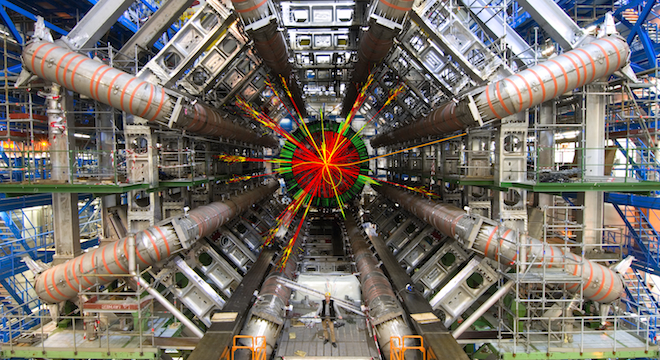The half-century-long hunt for the ellusive Higgs boson — a yet-unobserved particle that physicists theorize is responsible for giving all matter mass in the universe and has been nicknamed “the god particle” — could be quickly coming to an end, according to the scientists looking for it.
But wait, haven’t we heard that one before? Indeed, the scientists on the front lines of the search, those running high-energy particle physics experiments using the world’s largest and most powerful particle accelerator, the Large Hadron Collider (LHC), have for the past two years repeatedly stated that they were on the verge of confirming or ruling out the existence of the elusive Higgs.
But following the disappointment of the ambiguous data gathered from proton beam collisions in the LHC at the end of 2011, scientists with the European Organization for Nuclear Research (CERN), the organization that oversees the accelerator, say that surely, by the end of 2012, they will have discerned whether or not Higgs exists at all.
“We will know by the end of this year whether it exists or whether it is non-existent,” said Rolf-Dieter Heuer, director of the CERN, at a recent festival in Wales, as U.K. newspaper The Telegraph reported.
Other scientists at the University of Michigan involved in the search are even bolder in their prediction, publishing a video online at the end of May stating that the LHC could solve the puzzle by the end of the summer.
“We are optimistic for a number of reasons,” wrote the Michigan scientists, physics professor Jianming Qian and grad student Aaron Armbruster, in an email to TPM. “First of all, the results of the 2011 data have significantly narrowed downed possible Higgs mass region.”
Indeed, in August 2011, CERN scientists revealed that the existence of the Higgs had been ruled-out with a 95 percent probability between a range of 145 and 466 billion electron volts.
However, there is about a 99.4 precent possibility Higgs could have been formed in a smaller range of energy, between 115 and 130 billion electron volts. Scientists need to get that up to 99.99997 percent probability to say with confidence that it exists.
Further, as Qian and Armbruster explained to TPM, “the LHC machine has so far in 2012 delivered about 75 percent of the entire 2011 dataset,” putting it well ahead of last year’s search time-table.
Add to that the fact that the accelerator is running at a substantially higher energy level, a world record 8 trillion electron volts (TeV), compared to last year’s 7 TeV, means that the chance of Higgs being created in the aftermath of a proton beam collision are also increased dramatically.
“We’d characterize the current energy sufficient, not necessarily ideal,” Qian and Armbruster told TPM. “Given the high rate of production at higher energies, the Higgs search will likely benefit from higher energies. Of course, what the energy the LHC runs at is determined by many factors, among them the safety is the most important one.”
Still, even if Higgs is produced by a collision between two high-energy proton beams, the scientists will have a nearly infinitesimally short amount of time to detect the particle before it decays.
“It has a lifetime of about 10^(-24) second,” Qian and Armbruster said.
Still, the LHC should be up to the task, specifically the ATLAS detector a massive piece of equipment, half the size of Notre Dame cathedral, that sits on the 17-mile-around underground ring that forms the main portion of the accelerator.
If the Higgs is found not to exist, scientists will be forced to rethink the Standard Model, the prevailing theory modern physicists use to describe the universe and its laws, in favor of weirder alternatives like the technicolor theory which states that there is another missing “fifth” force that holds the universe together.
“If the Higgs boson is experimental excluded, we will need a new mechanism to explain particle mass,” Qian Armbruster added. “It may require significant modifications to the model.”
Correction: This article originally incorrectly stated that scientists needed to establish a 99.99997 percent probability in their measurements to determine the non-existence of Higgs, when it fact this value actually refers to the probability needed to claim a discovery. The article has since been corrected in copy and we regret the error.






